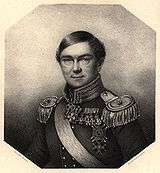Karl Ferdinand von Gräfe
Karl Ferdinand von Gräfe,[lower-alpha 1] (March 8, 1787 – July 4, 1840), was a German surgeon from Warsaw.[1]

He was the father of ophthalmologist Albrecht von Graefe (1828–1870) and grandfather of politician Albrecht von Graefe (1868-1933).
Biography
Gräfe studied medicine at Halle and Leipzig, and after obtaining his licence from Leipzig, he was in 1807 appointed a private physician to Duke Alexius of Anhalt-Bernburg. In 1811, he became a professor of surgery and director of the ophthalmological institute at the University of Berlin. His lectures at the University of Berlin attracted students from all parts of Europe.[2] During the Sixth Coalition against Napoleon, he was a superintendent of military hospitals.[3]
When peace was concluded in 1815, Gräfe resumed his professorial duties. He was also appointed physician to the general staff of the Prussian army, and he became a director of the Friedrich Wilhelm Institute and of the Medico-Chirurgical Academy (Charité).[2]
Gräfe died suddenly at Hanover, where he had been called to operate on the eyes of the crown prince.[2] His grave is preserved in the Protestant Friedhof II der Jerusalems- und Neuen Kirchengemeinde (Cemetery No. II of the congregations of Jerusalem's Church and New Church) in Berlin-Kreuzberg, south of Hallesches Tor.
He was a pioneer of plastic and reconstructive surgery, and a founder of German rhinoplastic surgery. He developed his own techniques in regards to rhinoplasty, being modifications of the Italian methods of Gasparo Tagliacozzi (1545–1599) as well as Indian surgical practices from long ago.[4][5] He also made contributions towards the development of cleft palate repair,[6] and was a pioneer of eyelid surgery, coining the term "blepharoplasty" in 1818.[7][8] He is also reputed to have carried out the first reported clitoridectomy in the Western Europe, which was done on a teenage girl regarded as an "imbecile" who was masturbating.[9]

Works
The following are his principal works:[2]
- Normen für die Ablösung größerer Gliedmaßen (Berlin, 1812) – Standards for the removal of larger limbs.
- Rhinoplastik (1818) – Rhinoplasty.
- Neue Beiträge zur Kunst, Teile des Angesichts organisch zu ersetzen (1821).
- Die epidemisch-kontagiose Augenblennorrhoe Ägyptens in den europäischen Befreiungsheeren (1824) – The epidemic involving ophthalmic blennorrhea in Egypt affecting the European liberation armies.
- Jahresberichte ber das klinisch-chirurgisch-augenarztliche Institut der Universität zu Berlin (1817-1834) – Annual reports on the clinical-surgical-ophthalmology institute at the University of Berlin.
With Philipp Franz von Walther, he edited the Journal für Chirurgie und Augenheilkunde.[10]
Notes
- Gräfe is often Anglicized to Graefe (See the article on Ä).
- Chisholm 1911, p. 315.
- Chisholm 1911, p. 316.
- Chisholm 1911, pp. 315–316.
- Manual of Head and Neck Reconstruction Using Regional and Free Flaps by Boban M Erovic, Piero Lercher
- The Atlantic Medical Weekly, Volumes 3-4
- The Medical Almanac: A Calendar of Dates of Significance to the Profession ... by Pasquale Accardo
- Subramanian, N (2008). "Blepharoplasty". Indian J Plast Surg. 41 (Suppl): S88-92. PMC 2825121. PMID 20174547.
- Advanced Therapy in Facial Plastic and Reconstructive Surgery by J. Regan Thomas
- Shorter 2008, p. 82; Elchalal 1997, pp. 643–651.
- Chisholm 1911, p. 316 cites Michaelis 1840
References
- Michaelis, E. (1840). Karl Ferdinand von Gräfe in seiner 30 jahrigen Wirken für Staat und Wissenschaft. Berlin.CS1 maint: ref=harv (link)
- Elchalal, Uriel; et al. (October 1997). "Ritualistic Female Genital Mutilation: Current Status and Future Outlook". Obstetrical & Gynecological Survey. 52 (10): 643–651. doi:10.1097/00006254-199710000-00022. PMID 9326757.CS1 maint: ref=harv (link)
- Shorter, Edward (2008). From Paralysis to Fatigue: A History of Psychosomatic Illness in the Modern Era. New York: Simon and Schuster. p. 82.CS1 maint: ref=harv (link)
Attribution:

Further reading
- Gilman, Sander L. (1999). Making the Body Beautiful: A Cultural History of Aesthetic Surgery. Princeton University Press. p. 80. ISBN 0-691-07053-9.
- "100 Years of Nasal Surgery". www.jacques-joseph.de. Retrieved 24 April 2016.
- "Carl Ferdinand Von Graefe Institute for the History of Plastic Surgery". www.histplastsurg.com. Archived from the original on 2 January 2014. Retrieved 24 April 2016. -Online Research Guide and Journal on the History of Plastic Surgery